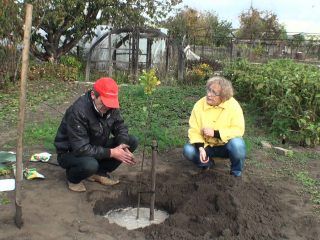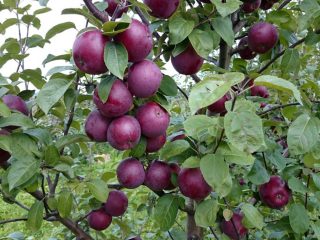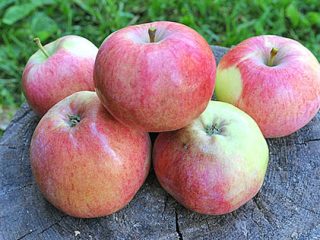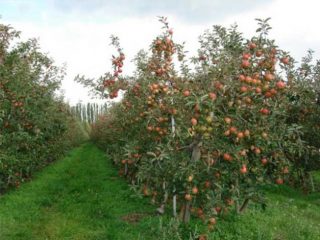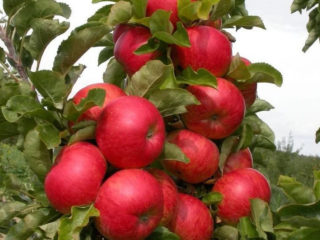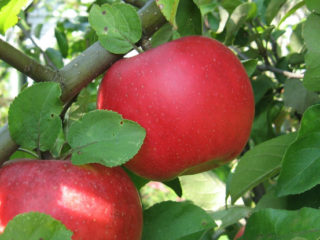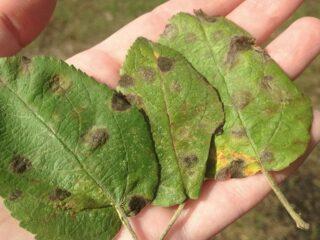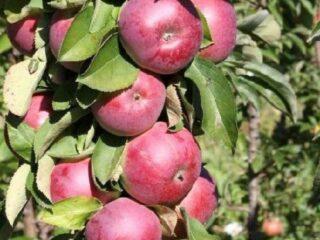Content
- 1 History of selection
- 2 Description and characteristics of the Cinnamon striped apple tree
- 3 Advantages and disadvantages
- 4 How to plant a Cinnamon striped apple tree
- 5 Rules of care
- 6 Disease and pest control
- 7 Harvest and storage
- 8 Conclusion
- 9 Reviews from gardeners about the Cinnamon striped apple tree
The Cinnamon Striped apple tree is one of the oldest varieties of folk selection, enjoying deserved popularity among gardeners in different regions of the country. The tree owes this to its unpretentiousness and excellent taste.
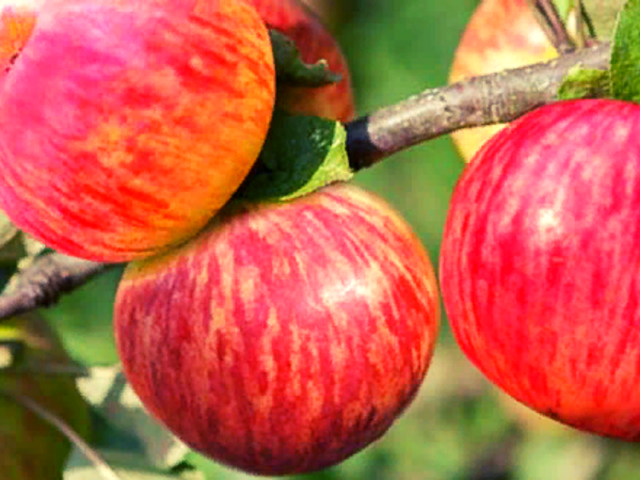
Cinnamon striped is an autumn variety of apples with an exquisite dessert taste and pleasant aroma.
History of selection
The Cinnamon Striped apple tree appeared so long ago (somewhere at the beginning of the 19th century) that there is no exact information about the origin of this variety. There is an opinion that the seedling grew as a result of free pollination of an unknown tree.
However, from 1941 to 1947 the variety passed all tests and in 1947 was entered into the State Register of the Russian Federation.
It was presented as zoned and recommended for cultivation in the Northern, Northwestern, Central, Volga-Vyatka, Central Black Earth and Middle Volga regions of Russia.
The official originator of the variety is OJSC "Taytsy" in the Leningrad region.
Currently, breeders use Cinnamon Striped to develop new varieties. Thus, new Cinnamon apple trees appeared, the description of the variety and photo of which are in many ways similar to the mother specimen, Cinnamon Pineapple and Cinnamon Smoky.
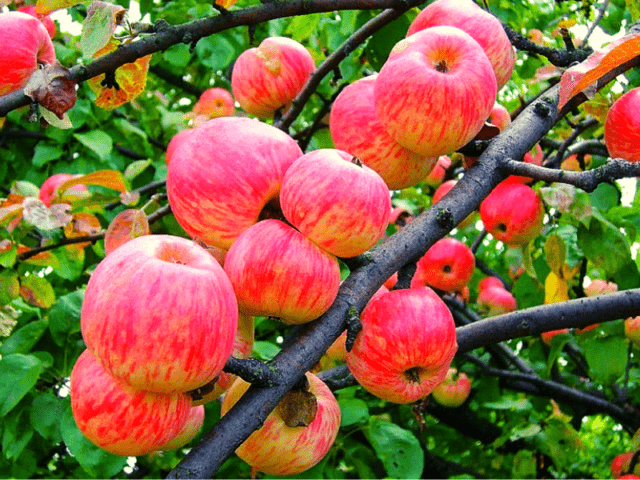
The first mention of the apple tree dates back to 1810
Description and characteristics of the Cinnamon striped apple tree
Depending on the type of rootstock, the Cinnamon Striped apple tree may look like a dwarf, semi-dwarf or tall tree. In addition to the real one, the variety has two more names - Cinnamon and Brown.
Wood appearance
The Cinnamon striped apple tree is a large spreading tree, the height of which in natural conditions reaches 6 m, and the crown diameter is about 5 m. When grown on a semi-dwarf rootstock, the crop is not so huge - no more than 5 m in height and 4 m in width.
The crown of the tree, which is broadly pyramidal or broom-shaped in the first years of life, after a few years becomes powerful, spreading, with branches hanging almost to the ground.
The relatively thin skeletal branches, located at an acute angle relative to the trunk, are covered with smooth red-brown bark.
The annual growth of the crown is small, the foliage of the shoots is weak - the leaves are located mainly on their tops, and the lower part in most cases remains bare.
Small, slightly convex vegetative buds are covered with microscopic villi.
The leaves of the non-columnar apple tree Cinnamon striped are oval-elongated, with a jagged edge, tapering at the base and towards the nose. In young seedlings they, as a rule, have a keeled, that is, reversed shape.
The light green leaf blades with a grayish tint are quite dense and slightly pubescent. The petioles are medium or short, the stipules are lanceolate or subulate.
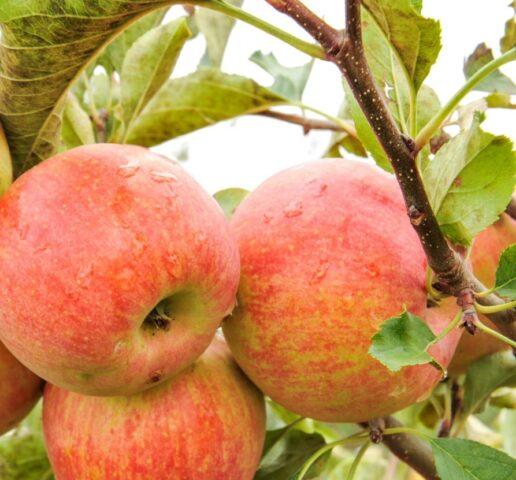
Branches often break under the weight of fruits
Description of fruits
The ripened fruits of the Cinnamon apple tree are striped (this can be seen in the photo of the tree), not very large - the weight of one is 70-100 g. Flat-round, slightly ribbed or smooth apples are covered with a thin but dense shiny skin.
A medium-sized funnel may have a slight rusty tint. The saucer is shallow, wide, and there are several small tubercles at the base of the sepals. The calyx can be half-open or closed. The fruit is attached to the generative parts of the tree using a long stalk.
Yellow-green at the stage of technical ripeness, by the time they ripen the apples become dark red with blurred stripes and small inclusions on the surface of the peel. The few white subcutaneous dots are almost invisible.
The pulp of the fruit is juicy and tender. It is mainly white-yellow in color, with the skin itself having a red-pink tint.
The tasting commission rated the sweet and sour, with subtle notes of cinnamon, taste of Cinnamon Striped apples at 4.88 points out of 5 possible.
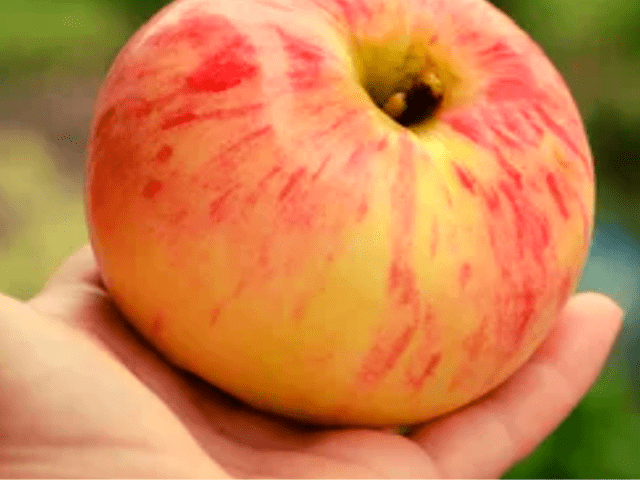
Some specimens can weigh about 150 g
Bloom
The flowering period of the Cinnamon Striped apple tree occurs in the middle, end of May (this depends on weather conditions in the region). The tree's medium-sized flowers are white-pink, five-petaled. During the flowering period, the apple tree emits a pleasant, intense aroma that attracts pollinating insects.
This crop is characterized by a mixed type of fruiting, that is, fruits are set on all generative formations - ringlets, fruit twigs and the tops of last year's shoots.
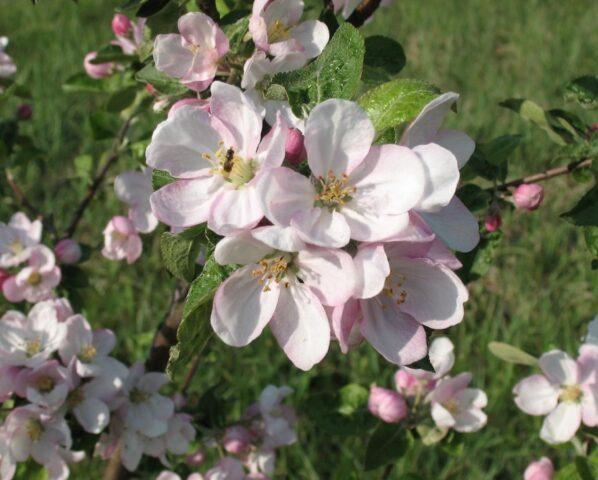
The overlap of petals on apple flowers is insignificant
Pollinators of the apple tree Cinnamon striped
The Cinnamon Striped variety is self-sterile, so it needs pollinating trees to form the ovary. Good neighbors for this apple tree will be its relatives Grushovka Moscow or Papirovka.
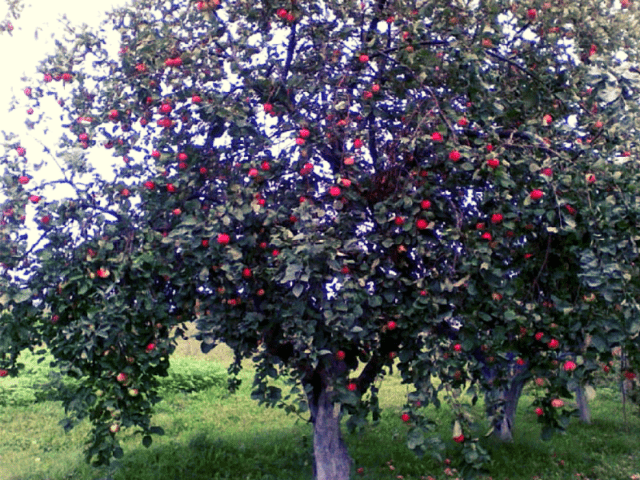
The distance between trees should be at least 3 meters
Ripening time for apple tree Cinnamon striped
According to the description, the Cinnamon striped apple tree, including dwarf and semi-dwarf, is an early autumn variety, the ripening period of which begins in late August, early September. At this time, the apples reach technical maturity and are ready to be picked.
Productivity
An apple tree of this variety cannot be called early-fruiting - the first fruits appear on it no earlier than seven years later. Moreover, in the first year of fruiting it will not be possible to get a good harvest either.
Increasing with each subsequent year, the yield reaches varietal indicators approximately by the tenth year of the tree’s life and amounts to approximately 150 kg of apples per tree.
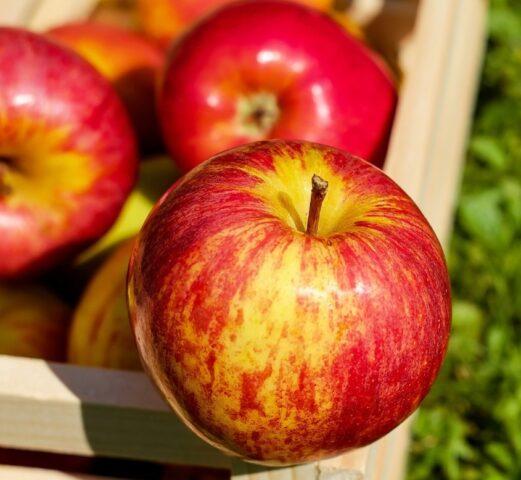
Under the right growing conditions, yields will be higher
Frost resistance of apple tree Cinnamon striped
The frost-resistant crop can withstand temperatures down to -37 °C. According to gardeners, some trees survived colder winters (up to 45 ° C). This allows you to grow apple trees in cool regions of the country, including Siberia.
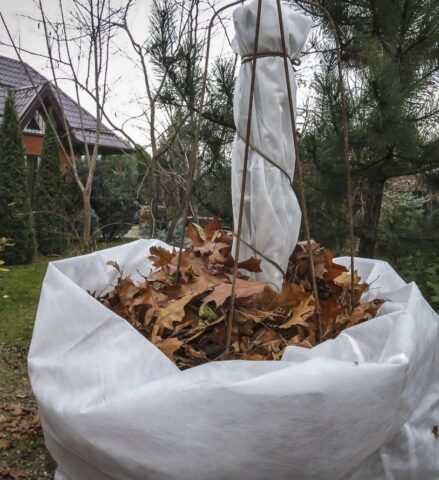
It is better to cover young seedlings for the winter
Resistance to diseases and pests
The apple tree has average resistance to diseases and pests. However, given the weak foliage, it suffers from some fungal diseases, in particular scab, less often than trees with dense crowns. The same situation applies to pests.
Advantages and disadvantages
The Cinnamon Striped apple tree has certain advantages. However, it also has many disadvantages.
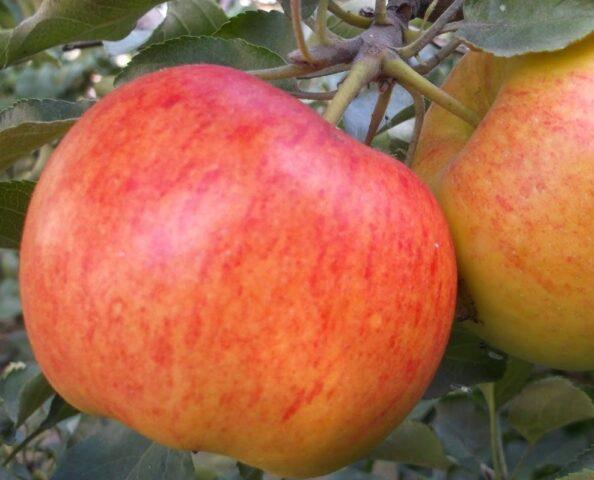
The apple tree adapts well to different climatic conditions
Pros:
- presentation and good taste;
- versatility of fruit use;
- high degree of frost resistance;
- long shelf life and the ability to transport over long distances.
Minuses:
- average yield;
- small fruit size;
- the impossibility of growing in small areas due to the tree being too large;
- tendency of fruits to shed;
- fragility of branches, which necessitates the construction of supporting structures during the ripening period of apples;
- late onset of fruiting (in the seventh year after planting).
How to plant a Cinnamon striped apple tree
Despite the fact that this apple tree is considered an unpretentious crop, experienced gardeners recommend purchasing seedlings in the region in which the tree will grow.If you bring planting material from areas with a warmer climate, they run the risk of not surviving the winter well.
Cinnamon striped apple trees are planted in spring and autumn. In cold regions, it is recommended to plant trees at the beginning of the growing season so that they have time to develop a full-fledged root system before the onset of winter.
The seedlings are placed in the center of a previously prepared planting hole and covered with earth so that the root collar is located 5-7 cm above the soil level.
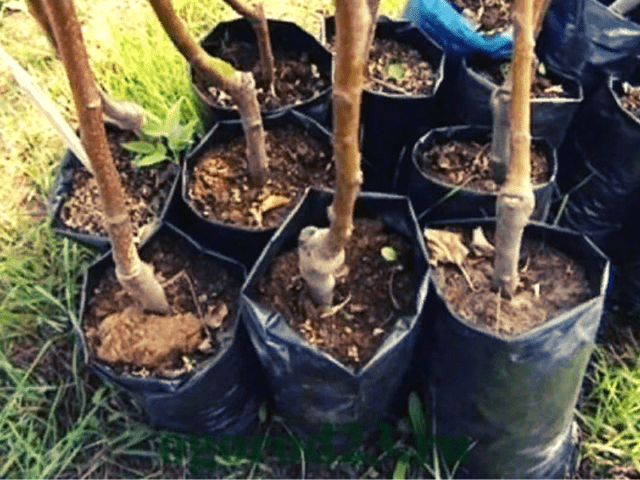
Further development of the tree depends on the quality of planting material
Rules of care
Caring for a Cinnamon Striped apple tree is not much different from caring for other trees.
In the list of events:
- Moisture-charging irrigation, which is done in spring and autumn. With normal precipitation, the tree does not require regular moisture, while in the dry season the apple tree is watered once a month.
- Feeding the tree - in spring and autumn, organic matter is added to the soil; during the period of budding and fruiting, the apple tree is fed with superphosphates.
- Prevention and treatment of diseases To prevent and treat fungal infections, trees are sprayed with fungicidal preparations, and treating the crown and trunk with insecticides will help get rid of pests.
- Crown trimming – dry, damaged and improperly growing shoots (tops) must be removed.
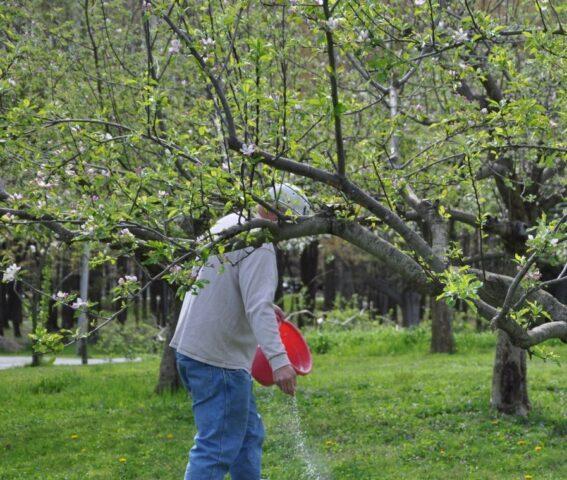
Fertilizers are applied to the tree trunk
Disease and pest control
The Cinnamon Striped apple tree does not have good disease resistance, so from time to time you have to fight a fungal infection. Pests also annoy the tree.
Scab
This is a fungal disease accompanied by the appearance of black spots on the leaves and fruits of the apple tree. In the process of treating scab, trees are sprayed with Fitosporin, Skor, Topaz.
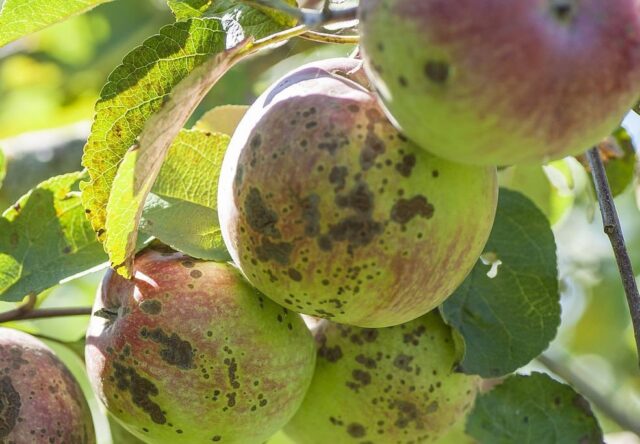
Affected apples are not recommended for consumption.
Black cancer
The development of the disease can be determined by coal-black, gradually increasing spots on the trunk and shoots. You can cope with the disease only at an early stage by removing the affected branches and disinfecting fresh wounds.
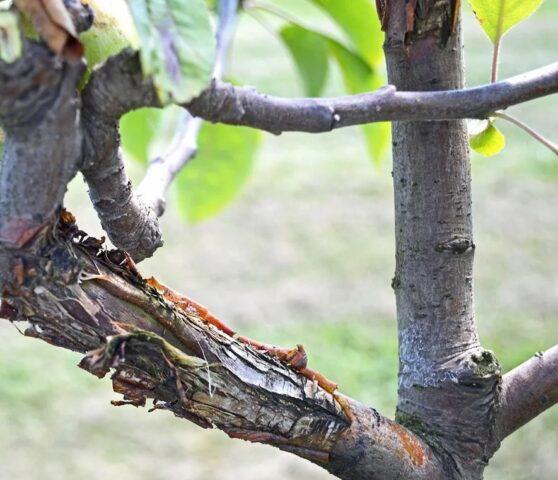
The affected parts of the shoots are destroyed
Aphid
This is a small insect that feeds on the sap of leaves and shoots of trees. You can cope with aphids by treating the crown and trunk with insecticidal preparations.
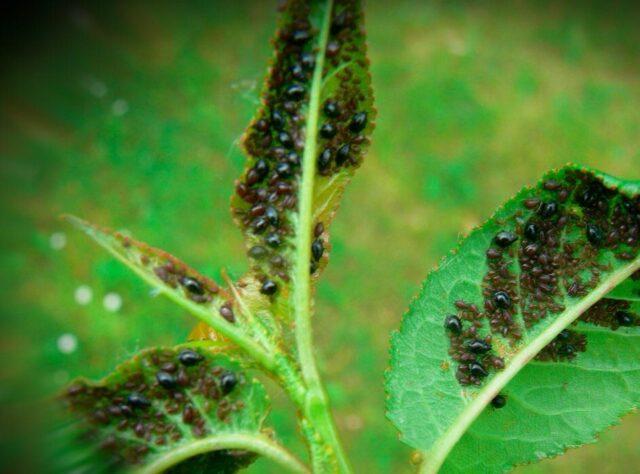
Aphids live on the inside of leaves
Apple moth
The larvae of this butterfly literally immediately after birth begin to devour the leaves and young shoots of the apple tree. To get rid of apple moth, trees are treated with Nitrofen or Zolon.
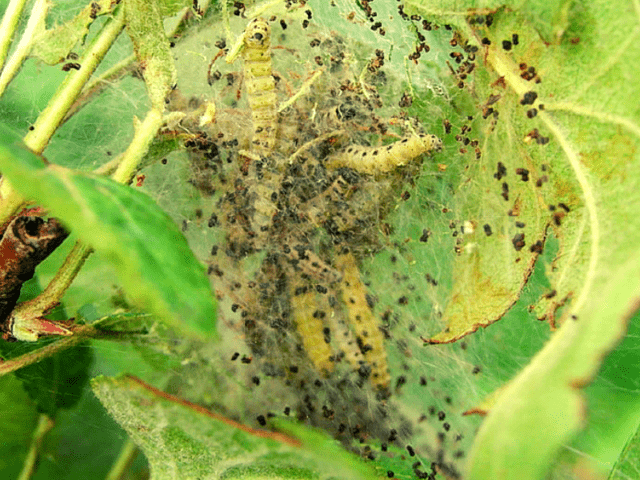
A small butterfly can cause great harm
Harvest and storage
Cinnamon striped apples are picked at the stage of technical ripeness and laid for ripening. They will finally ripen in a couple of weeks.
Fruits should be stored in a dry and well-ventilated area in a wooden or cardboard container. Cinnamon striped apples retain their freshness and presentation for three months.
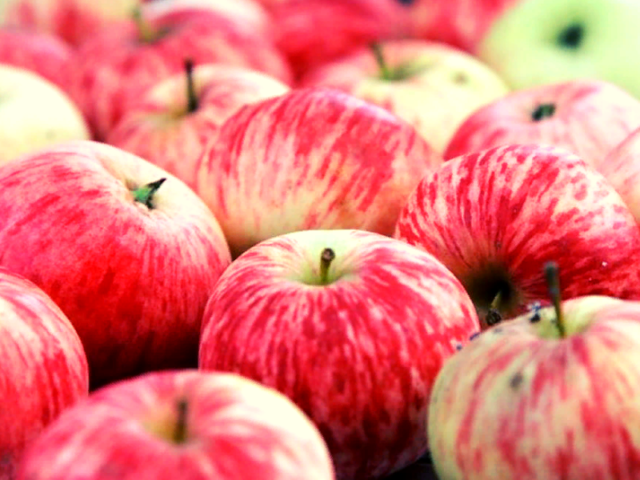
Fallen apples should be used as soon as possible
Conclusion
Despite the fact that the Cinnamon Striped apple tree pleases with its harvest only seven years after planting, it has been one of the popular varieties for many years. And the ease of care allows even novice gardeners to grow it.
Reviews from gardeners about the Cinnamon striped apple tree
